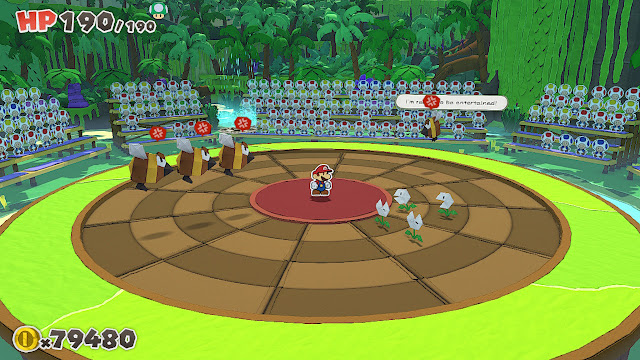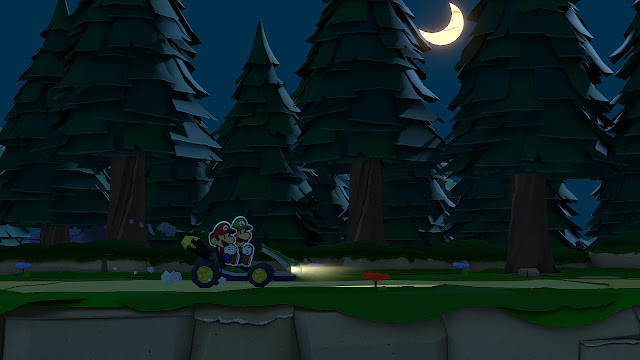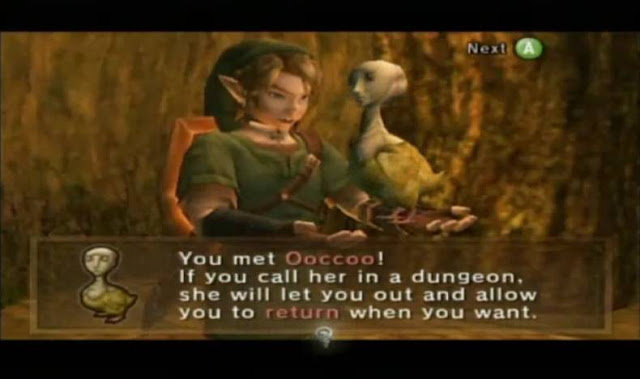This is a post I've been sitting on for a very long time. It's been most of a year since I finished playing Ni No Kuni, but I haven't felt like finishing and getting this out the door. Aside from normal procrastination, I think the problem is that, while Ni No Kuni is a great game, I had far too many hopes for the future of good JRPGs riding on it. I loved it and enjoyed pretty much every minute I spent playing it, but I always wanted it to be a little more than it was. It's a game that's easy to recommend to anyone willing to put a little time into a game, but it's also an illustration that it's the little things that separate very good games from the very best games.
As always with my
Thoughts on posts, there will be spoilers for the whole of Ni No Kuni.
Things I Liked
I loved the visual style of Ni No Kuni. Animated by
Studio Ghibli, everything is beautiful, charming, exotic and fun. Characters are easy to identify. Environments are beautifully rendered. Places are easy to see and navigate and remember. Animations are complex and realistic.
 |
| Running through the forrest. |
One of the small things, that speaks to the attention to detail the developers put into the game, is how well the main character Oliver transitions between different animations. You see him hop as he crosses a stream or jump from one mushroom to the next in the forrest and it's all simple and fluid with no weird grabbing of the character or stopping to load the animation (I'm looking at you
Tales of Graces). When Oliver goes up stairs he steps on each step.
You can also see this in Oliver's main companion in the story, Mr. Drippy Lord High Lord of the Fairies. He's very animated as he follows Oliver wherever he goes. At first I thought the he was just doing idle animations, but eventually I realized that he was subtly reacting to many of the actions I was taking in the game. In particular you can see him react when you cast magic, which given the story of the game makes sense.
The story is also very strong. Ni No Kuni might be dismissed as "kiddy," but there is a lot of depth and complexity to the story. In the early game Oliver's mother dies after rescuing him from the river, which he fell in due to a certain amount of irresponsibility. For a significant part of the game Oliver is trying to either resurrect his mother or find the instance of his mother in the other world. However, when it eventually becomes apparent that this isn't possible, he accepts it and stays strong under the other responsibilities he's been given. There's none of the general weak wishy-washyness that tends to accompany RPG (and particularly JRPG) protagonists and that makes the game much more enjoyable.
 |
| Walking to town is a little like walking into a Ghibli film. |
The end of the game caries through on this as well. There are no punches pulled at the end, no deus ex and no sudden then they all lived happily ever after. It's also heart-wrenching when Oliver dies in game and says "I'm sorry Mom".
Another thing I liked about the game was the Wizard's Companion. As a student wizard it makes sense that Oliver would need a text book and this makes having a manual for the game seamless. I regret not preordering the Wizard's edition of the game which came with a printed version, but having access to the manual as part of the game was very useful, although it would have been nice if the book reader was a little more usable. As a book lover having a book as a central pillar of the game both in universe and out was very enjoyable.
Things I Didn't Like
The biggest problem I had with with Ni No Kuni is the combat system. They've opted for a real-time, Pokemon-style approach, where in you switch out a series of monsters to fight along side your heroes. They've included a lot of factors in the combat system including the monster's affinity for different aspects of the heroes' personalities, different elemental rock-paper-scissors dynamics and different types of moves.
There are three big problems with the combat. The first is that during combat everything is extremely hectic and complicated. You and each of your two active allies (and you can eventually switch to a 3rd ally as well) can either fight yourselves or switch out with any of your three monsters. Everyone on your side has a large number of different powers they can use, all of which are very flashy. Meanwhile you are fighting several enemies all of whom have their own set of powers all of which also create a lot of visual noise. When viewed all at once can make it very complicated to see what's actually going on, beyond the complication of figuring out which tactics you should be using at any point in time.
 |
| It's easy to see what's going on here ... right? |
This leads to another problem with the combat system, which is that the AI is not very helpful. You're unable to directly control all three heroes at once, so you are required to rely on the AI for two-thirds of the actions your group is performing at any point in time. In some games with this real time system, it's possible at least to define some rules that the AIs can follow to be more useful, but in Ni No Kuni you only have a few options available. You can attack using all your magic powers (which means you never have magic points when you need them), you can attack using none of your magic powers, or you can heal (which means that they heal you all the time, again running out of magic points, but then also never attacking).
Beyond having poor control at the macro-level they also make poor choices at the micro level. Your partners will cast fire spells on fire monsters for no damage, heal you for conditions you don't have or put out the monster that is most vulnerable to the attack that's coming next. They tend to have very little beneficial impact on the game play. I can understand not wanting to have a game that wins itself without the player, but having useless partners is not a good either.
The third combat system problem is much larger overall. There is a huge range of choice available in monsters, monster training and equipment, however there's no real reason to make any of these choices. Now, I freely admit to having not wanted to invest too much time into the combat system, so I was happy to have a team that was "good enough" most of the time. That being said, switching between different monsters was mostly an aesthetic decision (aside from ensuring that I had coverage of the three elements), and powering up the different stats of the monsters was something that I did when I had too much stuff in my inventory (as determined when I was going through too many things, not a hard limit). Even managing weapons and armour was largely useless. With sixteen heroes and monsters, I really have no idea what anyone was equipped with at any point in time. Money was tight enough in the game that you had to limit what you bought, which tended to mean that I'd buy a couple of things for the most "interesting" team members and then let everyone else use hand-me-downs.
I'm sure that, for the interested, there's enough meat there for anyone to spend a significant amount of time maximizing their party's effectiveness, but I never had trouble that simply grinding for a half an hour (perhaps another issue with the game, but an aspect of the genre I'm willing to overlook) didn't solve.
Aside from the combat, another problem that the game really suffered from is an excess of potential solutions for problem solving. You spend a lot of time building or rebuilding bridges in Ni No Kuni, but there are at least 4 different spells that you can use to build or rebuild a bridge and the game not clear on why one would work while another wouldn't in a given situation. This results in your arbitrarily standing in the marked "use magic here" spot and casting every spell you know until you find the one that works.
This tends to be true every time magic is the solution to a situation, and considering the excessive hand holding that the game tends towards, it's very frustrating when the game suddenly abandons you to your magic list with no guide and no clue.
Better still would be to let all those different possibilities work. Oh, you figure out to rewind time until the bridge was there again, cool. Oh, you made a new bridge out of ice, cool. There's no reason in this game to not give the player points for trying
something. It would also let the game be more interactive and immersive with it's help, "oh hey, I can see you're trying to freeze the lava with the ice spell and that's not working, but did you know that there used to be a stone bridge here? Maybe that would be helpful".
The over abundance of solutions caries over to the alchemy system as well. In Dragon Quest VIII (also made by
Level-5), the alchemy system was frustrating because of the long delays in creating items, but you had a fairly clear idea what you were trying to do. In Ni No Kuni creating new items doesn't have long delays but it's often not easy to determine what you needed. Additionally, finding ingredients was frustrating (they're mostly released at certain points on the map at random moments). The items you end with can be useful and powerful, but for me at least it was almost never worth the time to make them and faster to go with the buyable alternatives.
Considering that I've already praised the game for the attention to detail put into it, there are some points where very simple details are missed out on. For example, you spend the whole of the game helping an NPC couple travel the world, learning all the things they need to know and getting all the supplies they need to start the worlds best store. In the very last stage of the game you're given access to a kick ass store with all the greatest items and weapons ... who runs this store? Totally different characters.
If I had to sum up the things I didn't like about the game it would be that the game is over built. It has more in party NPCs than it needs, it has more fighters than it needs, it has more mechanics than it needs and it has more solutions than it needs. I think the thing that would have taken Ni No Kuni from a very good game to an ageless great game is a serious round of editing.
Things I Noticed
I found the companions in this game a strange addition. On the one hand I think they helped form a lot of the story, but on the other hand I think the story of a lonely boy with his only friend the lamp-nosed fairy dude might also have been very compelling. As I already mentioned the AI in combat was at best unhelpful, so mechanically I don't think they were necessary. I also know that the story in Ni No Kuni is dark enough as it stands and having Oliver's friends travel with him gives the game and the story some brighter points to hold on to.
Another thing that would have been nice to see would to have seen how the concept of one of the greatest wizards / sages in a very long time effected the game world. I think this would have been interesting in two ways.
Firstly it would have been nice to see Oliver's magic getting stronger over time. For example, in the beginning your fast travel spell might just be able to pop you out in a few locations, but as you get stronger you can jump to each city and then eventually to anywhere you want in the world. This does a few things, first it cuts down a lot on the late game running back and forth where you need to meet someone who's a very long way away from a touch down point.
Secondly it allows the game to show you as becoming increasingly powerful outside of the combat system and outside of being told what a strong wizard you're becoming. It gives you the chance for a more subtle interaction with the people in the world, if you use your strong magic around them all the time it stands to unnerve them, so it becomes a choice on your part as to whether you frighten people both in Motorville and the other world or whether you avoid them.
 |
| You'd better be afraid of me! |
Things I'd Include in a Game
There are four things I would take, directly or indirectly, from Ni No Kuni to include in a game of my own. The first is that your power as it is represented and needed for the plot should both be effected by the game play and effect the game play. This could be implemented simply in better stats when you fight something, but it would be much better to feel the game mechanics change through the application for your power. A strong wizard should be able to
do more with a spell, a diplomat should be able to suggest more radical solutions or a general should be able to implement more dynamic actions. The scale varies with the game, but allowing the mechanics to grow with the players power allows the player to feel more invested.
The second thing I would take is that there need to be several solutions to a given problem. Especially in an RPG where the player is investing their time and personality into the player it does nothing to punish them for not guessing the right answer from a list. Letting different possibilities exist can be difficult, since you either need to predict them ahead of time or develop dynamic systems to manage them at the time they happen. However it gives the player more feeling of power (and cleverness) if they're able to proceed without being hindered by the "game" mechanic of the game. At a minimum the lesson to take from Ni No Kuni is that it's necessary to give clear hints when a particular mechanic should be applied.
The third thing is perhaps a given, but all of the elements of the game should build together in the same direction. In Ni No Kuni the story is supported by the style and the theme. These are supported by the game play (which is maybe not as thorough as it could be but still leads in the same directions). It makes the storytelling much more coherent than many games. Could Ni No Kuni have handled this better? Yes, there are times where they break the other elements for a game mechanic and there are times where a few extra mechanics would have made it easier to believe in the game. Overall however the polish they put on the game in this way is important and should be emulated.
Finally, I think including an in/out universe manual like the Wizard's companion is a must, at least for my own edification. Old books are cool and having a great thing to read about the video game I just got was one of the highlights of my childhood. I'd like to pass that feeling on.
Final Thoughts
Ni No Kuni is a great game. It doesn't, as I'd hoped, have quite enough strength to be one of the greatest games. Perhaps for me it's simply an aspect that nostalgia makes some of those greatest games (such as Chrono Trigger, Secret of Mana or Final Fantasy VI) seem better than they were at the time. Perhaps some of Ni No Kuni's rough edges will wear off over time and I'll feel more strongly for it. Even if it never does, it's a highly polished quality game that everyone should play.
 |
| Ni No Kuni is a magical journey? |
If you like JRPGs or you like Studio Ghibli films and you haven't played Ni No Kuni then there's no question that you should. It's worth the time investment, for the story as much as for the game play experience. It is linear so if you only somewhat interested I'm sure a good Let's play would give you nearly as good a feeling of the game. If you have the time to commit though I fully recommend playing it.
















































